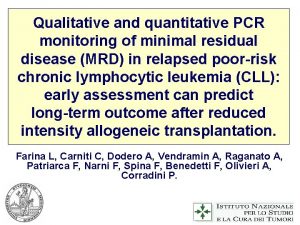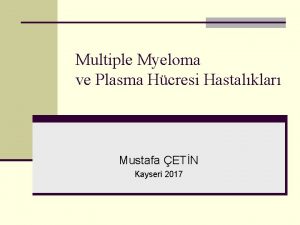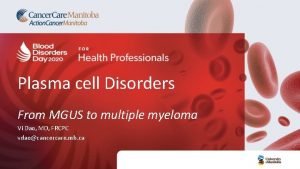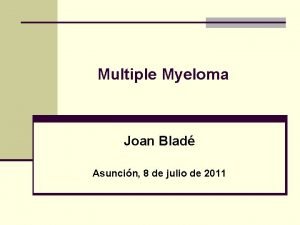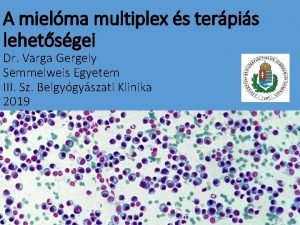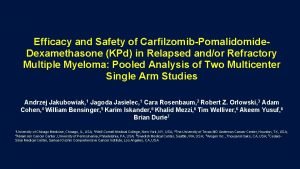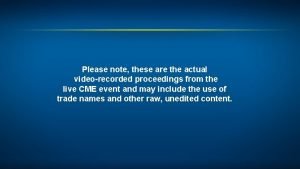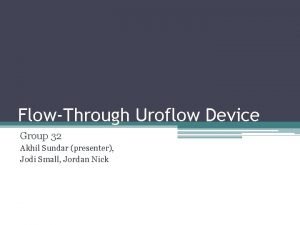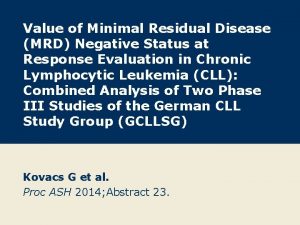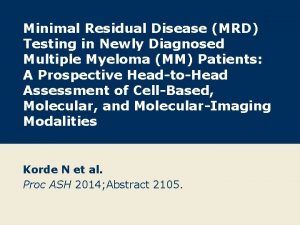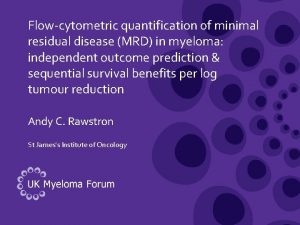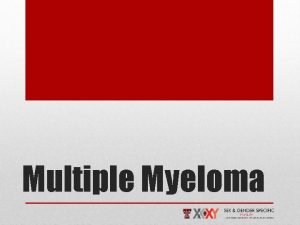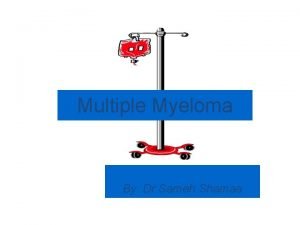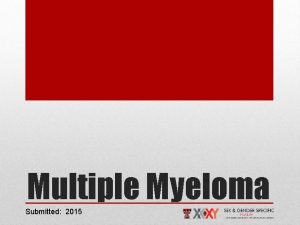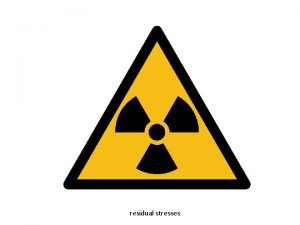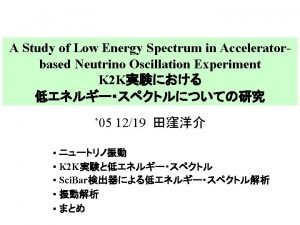Minimal Residual Disease MRD in Multiple Myeloma Sundar












- Slides: 12

Minimal Residual Disease (MRD) in Multiple Myeloma Sundar Jagannath, MD Professor of Medicine Icahn School of Medicine at Mount Sinai Tisch Cancer Institute New York, NY

Why is MRD important to multiple myeloma patients? CONCEPT: Eradication of tumor cells is necessary for a cure in most cancers Therefore, detection of minimal residual cancer cells still present is important EXCEPTION. (MGUS-like profile). A small number of residual tumour cells may persist under control of immune system for a long time (MM & low grade NHL)

What is MRD & depth of MRD? Minimal Residual Disease (MRD) is the small amount of cancer cells that still remain in the body after treatment Tumor cells 109 108 107 106 105 1 in 1, 000 CR 1 in 10, 000 SCR 1 in 100, 000 MRD by Flow Cytometry - Flow - NGS 104 1 in 1, 000 103 102 101 10 (Operational cure) 0 Time to progression Each testing method has its own limitations! MRD by DNA Fingerprinting Cy. TOF

Definitions for Depth of Response and MRD status Complete Remission (CR) – 1 cancer cell in 1, 000 No monoclonal protein (M-Spike) in serum or urine electrophoresis Serum and Urine IFE is negative – no monoclonal band detected Bone marrow biopsy has <5% plasma cells, not monoclonal Stringent Complete Remission (s. CR) – 1 cancer cell in 10, 000 Next generation Flowcytometry (MRD negative by NGF) – 1 in 100, 000 Bone marrow aspirate, evaluate >5 million cells to detect monoclonal plasma cells using antibodies that can distinguish tumor plasma cells from normal bone marrow cells Next Generation DNA Sequencing (MRD negative by NGS) – 1 in 1, 000 + kappa/Lambda light chain ratio normal Bone marrow aspirate, need >1 million cells to detect tumor plasma cells by DNA finger print technique Liquid Tumor biopsy Peripheral blood cells, to detect circulating tumor plasma cells by DNA finger print Plasma, to detect circulating pieces of unique tumor cell DNA (Cell Free DNA)

MRD testing by flow cytometry

MRD testing by Mass Cytometry (Cy. TOF) • • • FACS uses fluorophores as labels of antibodies FACS is limited to 10 colors because of spectral overlap Cy. TOF substitutes isotopes of elements as labels for antibodies Cells are vaporized and isotopes are analyzed by Time Of Flight mass spectrometer Accurately measure 34 markers simultaneously on every cell that is analyzed; up to 100 may be possible • • 13 cell surface Ag 18 additional intracellular parameters Sean C. Bendall et al. Science 2011; 332: 687 -696

MRD testing by Mass Cytometry (Cy. TOF) Total plasma cells Mass Cytometry (Cy. TOF) Ig. K Count % of total Total singlet events 753779 100. 00 Normal Ig. K PC 14154 1. 88 48. 36 Normal Ig. L PC 11489 1. 52 39. 26 Abnormal PC 3623 0. 48 12. 38 Ig. L CD 19 CD 45 RA CD 27 CD 56 % of PC CD 39 HLA-ABC

Future of MRD testing Non-invasive testing – deep analysis of peripheral blood and bone marrow Anderson et al Clin Cancer Res; 23(15) 3980 -3993

Why is MRD important to multiple myeloma patients? CONCEPT: Eradication of tumor cells is necessary for a cure in most cancers Therefore, detection of minimal residual cancer cells still present is important EXCEPTION. (MGUS-like profile). A small number of residual tumour cells may persist under control of immune system for a long time (MM & low grade NHL)

MGUS-like signature for identification of non-responding non-relapsing active MM patients TTP 100 80 Median: NR 59% at 10 y 60 MM-like profile MGUS-like profile Median: 44 months 14% at 10 y 40 (N = 639) (N = 59) 20 0 Principal component analysis HR: 3. 27 ; P < 10 -6 0 20 40 60 80 100 120 140 Time from diagnosis (months) MGUS-like profile (n=59) MM-like profile (n=639) Paiva B, et al. Leukemia. 2013; 27(10): 2056 -2061.

MRD signifies longer duration of remission Munshi et al. JAMA Oncol. 2017; 3(1): 28 -35

IMWG criteria for MRD in multiple myeloma Response subcategory (Requires CR as defined below) IMWG MRD negativity criteria Sustained MRD-negative Response criteria MRD negative in the marrow (next-generation flow or next-generation sequencing) and by imaging as defined below, confirmed one year apart. Subsequent evaluations can be used to further specify the duration of negativity (e. g. , MRD negative at 5 years) Imaging-positive MRD negativity as defined by next-generation flow or next-generation sequencing PLUS MRD-negative disappearance of every area of increased tracer uptake found at baseline or a preceding PET/CT OR decrease to less mediastinal blood pool SUV or decrease to less than that of surrounding normal tissue Flow MRD-negative Absence of phenotypically aberrant clonal plasma cells by next-generation flow cytometry on bone marrow aspirates using the Euro. Flow standard operation procedure for MRD detection in MM (or validated equivalent method) with a minimum sensitivity of 1 in 10 5 nucleated cells or higher Sequencing MRD negative Absence of clonal plasma cells by next generation sequencing on bone marrow aspirates in which presence of a clone is defined as less than 2 identical sequencing reads obtained after DNA sequencing of bone marrow aspirates using the Lympho. SIGHT ® platform (or validated equivalent method) with a minimum sensitivity of 1 in 10 5 nucleated cells or higher CR defined as negative immunofixation on the serum and urine and disappearance of any soft tissue plasmacytomas and <5% plasma cells in bone marrow aspirates Kumar SK, et al. Lancet Oncol 2016; 17: e 328– 46.
